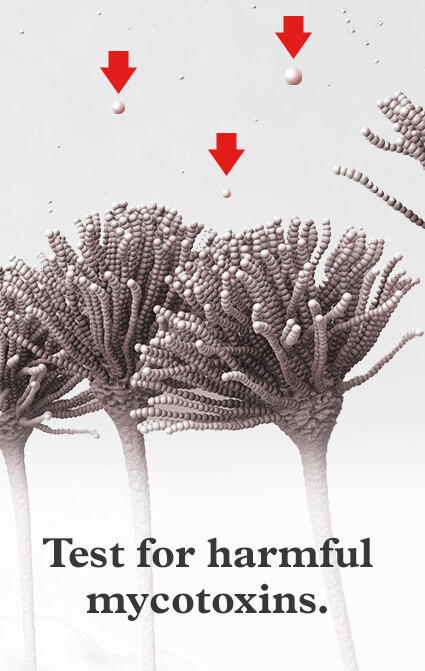Discover the Advantages of Specialist Mycotoxin testing Services Today
Ensuring Compliance With Rules: the Role of Mycotoxin Evaluating in High Quality Control
Making sure conformity with strict policies is critical for maintaining food safety and security, and the function of mycotoxin testing in quality assurance can not be overemphasized. Mycotoxins, poisonous substances created by certain molds, position considerable wellness risks, making their detection important in food manufacturing. Adherence to governing standards, such as those set by the FDA and EU, calls for durable testing approaches and innovations to identify and evaluate these impurities. By implementing complete testing methods, firms can protect against potential health situations, avoid pricey recalls, and maintain customer count on. Nevertheless, the complexities of these testing procedures raise essential inquiries concerning their efficiency and efficiency.
Understanding Mycotoxins
Understanding mycotoxins is essential to ensuring the high quality and safety and security of farming items. The most well-known mycotoxins consist of aflatoxins, trichothecenes, fumonisins, and ochratoxins, each linked with certain fungal varieties and environmental problems.
The existence of mycotoxins in foodstuff can cause intense and persistent wellness concerns, consisting of liver damages, immune reductions, and carcinogenic results. Consequently, their discovery and metrology are critical components of quality control in farming and food sectors. The intricacy of mycotoxin contamination requires a multifaceted approach, using advanced logical techniques such as liquid chromatography, mass spectrometry, and enzyme-linked immunosorbent assays (ELISA) By comprehending the resources, kinds, and effects of mycotoxins, stakeholders in the farming market can better carry out preventative actions and minimize dangers, making sure safer consumption for end-users. This understanding develops the bedrock whereupon reliable mycotoxin management practices are built.
Regulatory Standards for Mycotoxins
Having developed a foundational understanding of mycotoxins and their influence on food safety, it is vital to examine the regulatory standards regulating their existence in agricultural products. Regulative criteria for mycotoxins are vital due to the fact that they specify allowable limits, guaranteeing food security and securing public health and wellness. Different worldwide and national agencies have set these limits based on extensive danger analyses.
The Codex Alimentarius Payment, an international body established by the FAO and WHO, gives standards and maximum allowable degrees for different mycotoxins in food and feed. For instance, the Codex has set limitations for aflatoxins in peanuts, maize, and dried out figs, to name a few assets. These criteria are commonly embraced or adjusted by specific nations to fit their specific requirements.
In the European Union, Policy (EC) No 1881/2006 specifies optimum levels for several mycotoxins, such as aflatoxins, ochratoxin A, and deoxynivalenol, in different food products. The U.S. Food and Drug Management (FDA) has developed action levels for mycotoxins like aflatoxins in assets such as nuts and grains.
Adherence to these regulatory requirements is critical for preserving market accessibility, customer depend on, and public health. Non-compliance can lead to considerable economic losses and health and wellness risks, emphasizing the relevance of rigid mycotoxin screening procedures.
Evaluating Methods and Technologies

ELISA is widely appreciated for its rapid and economical testing capabilities, making it perfect for high-throughput environments. It counts on antibodies to identify details mycotoxins, offering cause a relatively short time frame. Nonetheless, its level of sensitivity may be restricted compared to a lot more sophisticated strategies.
HPLC, on the other hand, excels in giving measurable analysis with high accuracy and precision. It divides complex combinations right into specific parts, making it very efficient for determining and quantifying several mycotoxins simultaneously - Mycotoxin testing Services. This method, while extra resource-intensive and lengthy than ELISA, supplies a higher level of integrity

LC-MS represents the pinnacle of logical specificity and sensitivity. Integrating the splitting up power of fluid chromatography with the detection abilities of mass spectrometry, LC-MS can detect even trace degrees of mycotoxins. This approach is essential for validating the existence of mycotoxins in regulatory and forensic contexts, ensuring conformity with strict safety and security requirements.
Implementing Examining Methods

Integrating these innovative screening methods into an extensive top quality control framework demands a well-structured technique to implementing screening procedures. To accomplish this, companies must first conduct a detailed risk assessment to identify potential mycotoxin contamination points within the supply chain. This evaluation notifies the growth of a customized testing technique that addresses particular vulnerabilities.
Next, developing standardized tasting treatments is important. Consistent tasting guarantees that examination results are trustworthy and representative of the entire set (Mycotoxin testing Services). Abiding by standards from governing bodies, such as the FDA or EFSA, aids maintain compliance and improves the reliability of the screening procedure
Educating employees is an additional critical component. Staff needs to excel in both example collection and the operation of testing devices. Regular training sessions and certification programs can make certain that employee remain upgraded with the most up to date methods and governing adjustments.
Advantages of Mycotoxin Examining
Mycotoxin screening uses many advantages that significantly improve the safety and quality of food and feed items. Mainly, it functions as a crucial control action to stop contaminated products from getting to the consumer market, consequently securing public wellness. By recognizing and evaluating mycotoxins such as fumonisins, ochratoxins, and aflatoxins, producers can make sure that their items satisfy strict regulatory requirements, hence avoiding potential legal effects and associated expenses.
Furthermore, mycotoxin testing adds to the economic practicality of food and feed industries by reducing the visit the site danger of large-scale product remembers. The capability to isolate and identify contaminated batches early in the manufacturing procedure reduces waste and protects against the monetary losses connected with damaged brand online reputation. It fosters consumer depend on and commitment, as clients are increasingly aware of food security concerns and demand greater top quality standards.
The implementation of regular mycotoxin testing also promotes best practices within agricultural and manufacturing sectors. By adhering to extensive screening procedures, firms can maximize their quality assurance processes, improve operational effectiveness, and guarantee the consistent manufacturing of risk-free, top quality items. Finally, the advantages of mycotoxin screening are complex, adding to public health, financial stability, and sector integrity.
Conclusion
Mycotoxin screening is crucial in making sure conformity with regulatory criteria, read here thereby preserving food safety and security and top quality control. Thus, mycotoxin testing stays an indispensable element of contemporary food safety and security management systems.
Guaranteeing conformity with rigid laws is critical for preserving food security, and the duty of mycotoxin testing in quality control can Visit Your URL not be overemphasized.In the world of mycotoxin screening, progressed technologies and methods are critical in guaranteeing food security and regulative conformity.Mycotoxin screening supplies numerous benefits that substantially enhance the safety and high quality of food and feed items.Mycotoxin screening is crucial in guaranteeing conformity with regulatory standards, thus maintaining food safety and security and top quality control. Therefore, mycotoxin screening continues to be an indispensable element of modern food security monitoring systems.